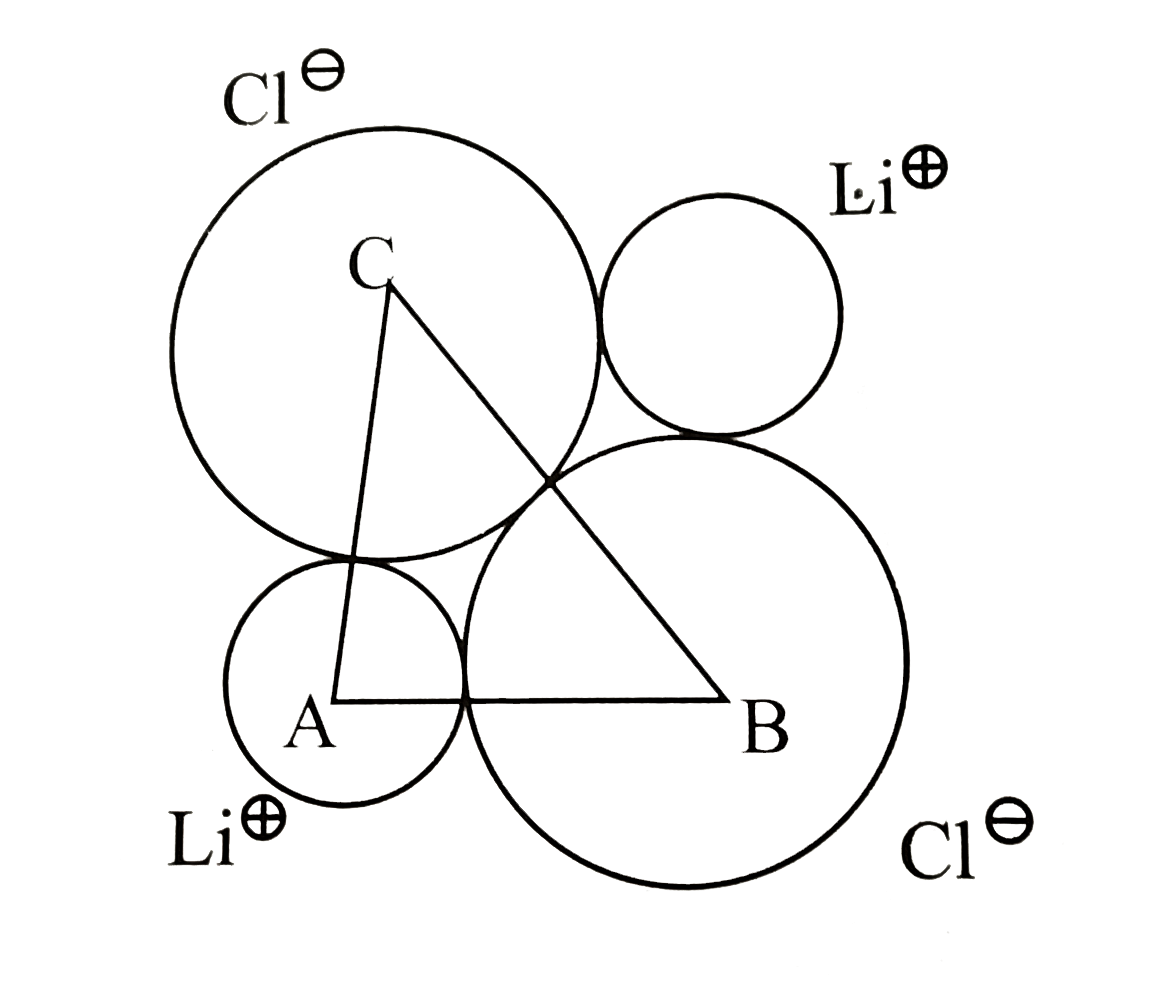LiCl has rock salt structure, with an edge length of 6.0Å. If anions are in contact, the ionic radius of chloride ion is
2.12 Å
1.82 Å
4.24 Å
3.68 Å
The correct Answer is:A
To find the ionic radius of the chloride ion (Cl⁻) in LiCl, which has a rock salt structure, we can follow these steps:
1. Understanding the Structure:
- LiCl crystallizes in a face-centered cubic (FCC) structure, also known as the rock salt structure. In this arrangement, the chloride ions (Cl⁻) are located at the corners and the centers of the faces of the cube, while the lithium ions (Li⁺) occupy the octahedral voids.
2. Given Data:
- The edge length (a) of the cubic unit cell is given as 6.0 Å.
3. Face Diagonal Calculation:
- In an FCC structure, the face diagonal can be calculated using the formula:
Face diagonal=a√2
- Substituting the given edge length:
Face diagonal=6.0Å×√2≈6.0Å×1.414≈8.485Å
4. Ionic Radii Relationship:
- In the FCC structure, when the anions (Cl⁻) are in contact along the face diagonal, the distance across the face diagonal is equal to the sum of the radii of the two chloride ions:
Face diagonal=4r
- Here, r is the ionic radius of the chloride ion.
5. Setting Up the Equation:
- From the face diagonal calculation:
4r=8.485Å
6. Solving for the Ionic Radius r:
- Rearranging the equation to find r:
r=8.485Å4≈2.121Å
Final Answer:
The ionic radius of the chloride ion (Cl⁻) in LiCl is approximately 2.121 Å.
---
- LiCl crystallizes in a face-centered cubic (FCC) structure, also known as the rock salt structure. In this arrangement, the chloride ions (Cl⁻) are located at the corners and the centers of the faces of the cube, while the lithium ions (Li⁺) occupy the octahedral voids.
- The edge length (a) of the cubic unit cell is given as 6.0 Å.
- In an FCC structure, the face diagonal can be calculated using the formula:
Face diagonal=a√2
- Substituting the given edge length:
Face diagonal=6.0Å×√2≈6.0Å×1.414≈8.485Å
- In the FCC structure, when the anions (Cl⁻) are in contact along the face diagonal, the distance across the face diagonal is equal to the sum of the radii of the two chloride ions:
Face diagonal=4r
- Here, r is the ionic radius of the chloride ion.
- From the face diagonal calculation:
4r=8.485Å
- Rearranging the equation to find r:
r=8.485Å4≈2.121Å
The ionic radius of the chloride ion (Cl⁻) in LiCl is approximately 2.121 Å.
Topper's Solved these Questions
- SOLID STATESBook:NARAYNAChapter:SOLID STATESExercise:EXERCISE-3
Explore 52 Videos
- QUALITATIVE ANALYSISBook:NARAYNAChapter:QUALITATIVE ANALYSISExercise:Subjective Type Question
Explore 33 Videos
- SOLUTIONS & COLLIGATIVE PROPERTIES Book:NARAYNAChapter:SOLUTIONS & COLLIGATIVE PROPERTIES Exercise:EXERCISE : 4
Explore 26 Videos
Similar Questions
Knowledge Check
LiCl has rock salt structure, with an edge length of 6.0A∘. If anions are in contact, the inoic radius of chloride ion is
A2.12A∘B1.82A∘C4.24A∘D3.68∘Consider a binary solid (A+B−) of rock salt structure with an edge length of 400 pm. If the radius of cation is 75 pm, then what is the radius of anion?
A100 pmB125 pmC250 pmD325 pmA binary solid (AB) has a rock salt structure. If the edge length is 400pm, radius of cation is 80pm the radius of anion is:
A100pmB120pmC250pmD325pm
The unit cube length for LiCl (NaCl structure) is 5.14Å. Assuming anion-anion contact, calculate the ionic radius for chloride ion.

View SolutionA binary solid (A+B−) has a rock salt structure. If the edge length is 400 pm and radius of cation is 75 pm, than the radius of anion is
View SolutionThe unit cell cube length for LiCl(just like NaCl structures) is 5.14Å. Assuming anion-anion contact, the ionic radius for chloride ion is:
View SolutionA binary solid (AB) has a rock salt structure. If the edge length is 400pm, radius of cation is 80pm the radius of anion is:
View SolutionA binary solid (A+B−) has a ruck salt structure. If the edge length is 400pm and radius of cation is 75pm the radius of anion is
View Solution

